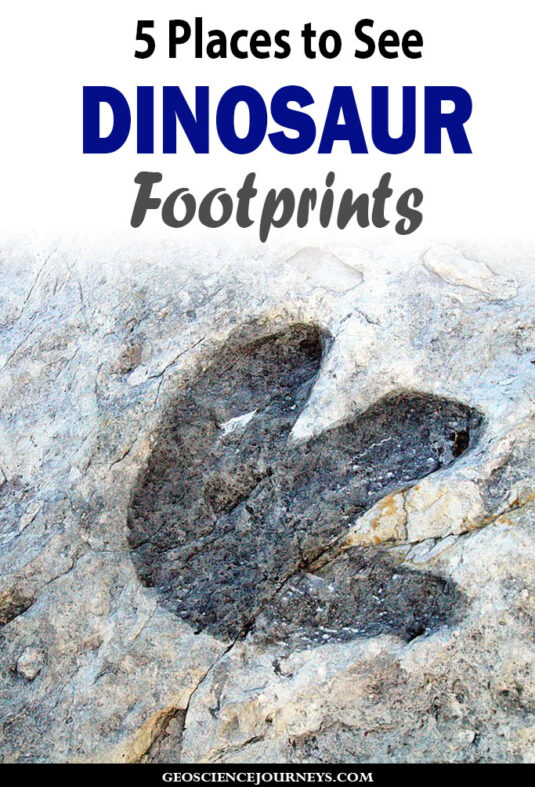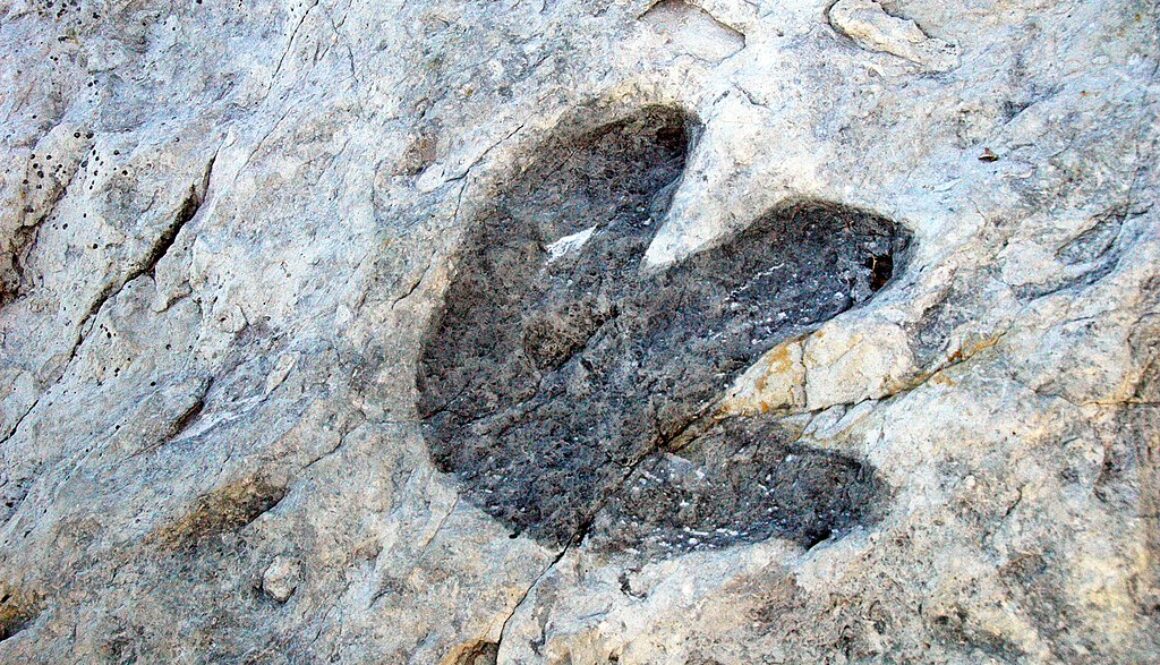5 Places to See Dinosaur Footprints
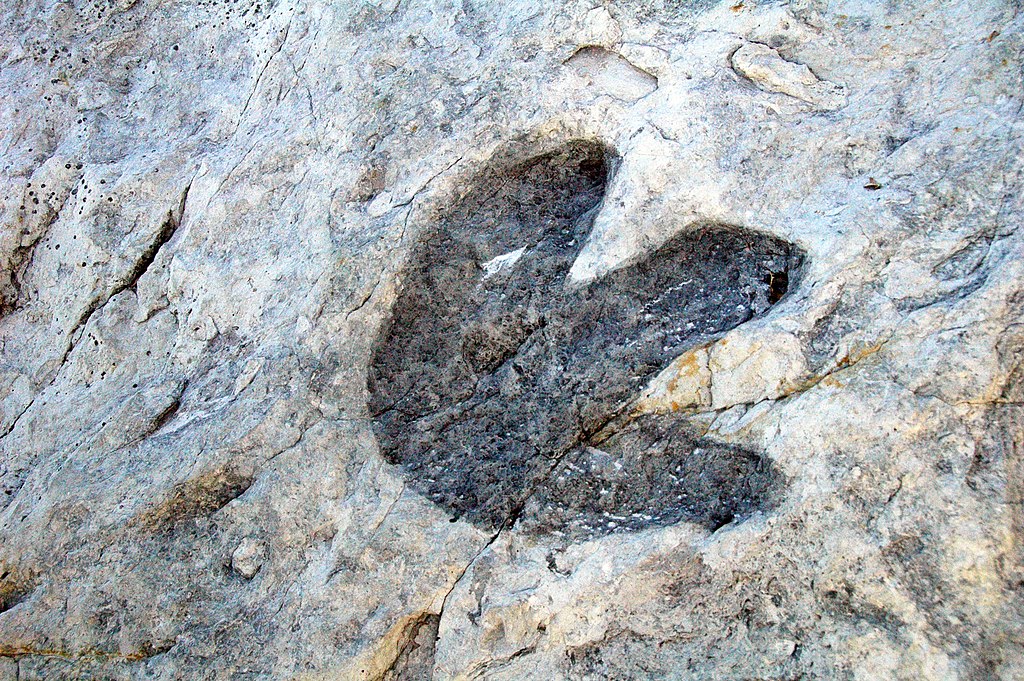
The Earth was very different ~100 million years ago. It was much warmer, and higher levels of carbon dioxide in the atmosphere allowed plants to thrive, the continents were splitting apart, and shallow seas covered much of the land. The biggest difference though was that dinosaurs roamed about just like animals do today. You can see dinosaur footprints today at certain places.
It’s hard to imagine these extinct creatures now. They left behind clues to their existence though in their fossilized bones and also their footsteps. Just like when you walk on the beach and leave your footprints, dinosaurs did this too. Sometimes those footsteps were buried and preserved into rock in what are called tracksites. The following are some of the places where you can see real dinosaur footprints today.
Spyway Dinosaur Footprints, Jurassic Coast
- Where: Purbeck, UK
- Age of tracks: Jurassic, 145 million years ago
- Dinosaur types: Sauropods
If you’ve seen the 1993 blockbuster movie ‘Jurassic Park,’ then you’ll know the moment that Drs. Grant and Sattler, both paleontologists, get their first view of a real life walking dinosaur. I still get chills watching that scene to this day. That giant plant-eating dinosaur is a brachiosaurus, part of the sauropod family.
The Spyway Dinosaur Footprints tracksite has the footprints of these giant sauropods from the past. You can get to the tracksite from the Priest’s Way walking trail. It sits next to a working quarry where there are more than 100 fossilized tracks.
Dinosaur Coast, Dampier Peninsula
- Where: Kimberley region, Western Australia
- Age of tracks: Cretaceous, 130 million years ago
- Dinosaur types: Theropods, Sauropods, Ornithopods, Thyreoporans
During low tide, the rocky beaches of Western Australia exhibit the clues to a thriving dinosaur population of the past, fondly known as the “Cretaceous equivalent of the Serengeti.” The sandy rocks along the shore today belonged to the sands of a tidal flat in the past where several species of dinosaurs sometimes emerged from the forest to get a drink of water.
The Dinosaur Coast stretches along the beaches of the Dampier Peninsula. Visitors can hunt for different tracks of different species all along the coast with help from an app. To find the biggest fossilized footprint known, it’s best to head to James Price Point where giant sauropod tracks are abundant at low tide.
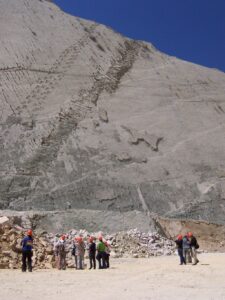
Dinosaur tracks in Bolivia / Photographed by Jerry Daykin, CC BY 2.0, via Wikimedia Commons
Cal Orck’o, Cretaceous Park
- Where: Sucre, Bolivia
- Age of tracks: Cretaceous, 68 million years ago
- Dinosaur types: Theropods, Sauropods, Ornithopods, Ankylosaurs
Most places you’ll find dinosaur tracks are flat. When you’re walking on the ground to find the tracks, the dinosaurs walked just like you on that same ground. However, at Cal Orck’o you will stare up at a vertical wall of rock to see the criss-crossing tracks. This wall used to lie flat, but the formation of the Andes Mountains thrust this rock layer into the sky along with these fossilized footprints.
The longest trackway in the world exists here at 550 meters long, and it belongs to a theropod. Most footprints show regular tracksite patterns like this, but some are quite irregular. Since discovery, paleontologists have lovingly dubbed this wall the “dinosaur dance floor.” Cal Orck’o is part of a museum open to the public with dinosaur exhibits of skeletons and fossils.
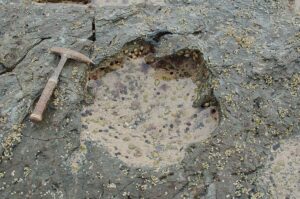
Dinosaur Isle, Skye
- Where: Staffin, Scotland
- Age of tracks: Jurassic, 170 million years ago
- Dinosaur types: Theropods, Sauropods, Ornithopods
The discovery of dinosaur tracks on the Isle of Skye is relatively recent, beginning in 2015 with a huge track array find of sauropod footprints. In 2018, paleontologists found additional prints and discovered that the giant plant-eaters were sharing their spot with meat-eaters.
The tracksites of Dinosaur Isle are important in that they represent a large portion of all known middle Jurassic footprints, and fossil hunters have flocked to the island because of this. The best places to find dinosaur tracks at the Isle of Skye are An Corran Beach, Brothers’ Point, and at the shore by Duntulm Castle.
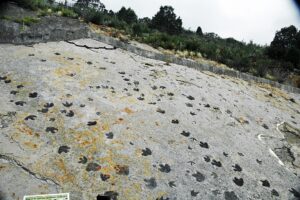
Dinosaur Ridge Trail
- Where: Morrison, CO, USA
- Age of tracks: Cretaceous, 100 million years ago
- Dinosaur types: Theropods, Ornithopods
Discovered in 1877, this tracksite is ranked #1 in the United States and is located just outside of Denver. More than 300 different tracks have been discovered, and several different dinosaur species have been identified making this place a prehistoric dinosaur party.
Located just off Highway 470, Dinosaur Ridge can be accessed by walking along a 2-mile long trail. The Dinosaur Ridge tracksite is part of a series of tracksites located along the eastern edge of the Rockies. This area used to be the western shores of the Cretaceous Interior Seaway and has earned the name “Dinosaur Freeway.”
Dinosaurs roamed the Earth for about 165 million years, and they finally went extinct about 65 million years ago at the end of the Cretaceous. This specific point in time is referred to as the K-T boundary. It marks an end in the age of reptiles and beginning in the age of mammals. The generally accepted scientific theory is that a large asteroid impacted the Earth and caused the extinction of dinosaurs, but it still remains a mystery and several other hypotheses exist.
Check out this and other geologic theories that still remain a mystery here.
